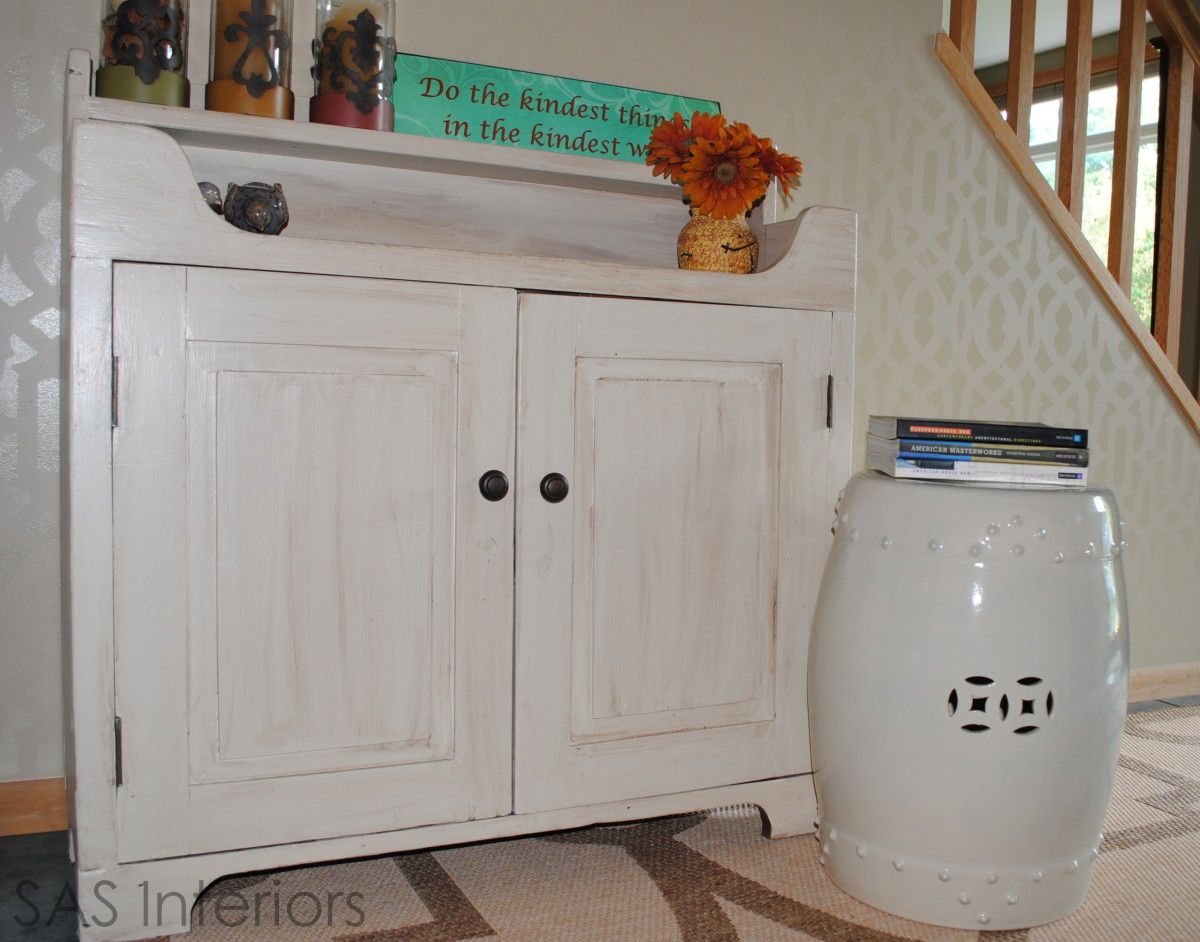DIY: Cabinet Makeover with Glaze Overlay
Last week I shared my latest DIY: How-to Stencil project where I transformed one of the walls in my foyer.
Did you happen to notice the cabinet in the pictures?
It’s new. Well not really “new” in the sense of just bought, but new to the place it now sits. AND it just got a huge makeover!
This cabinet is about 40 years old. My mom had it for about the first 35 years and I’ve had it for the last 5 (it’s had quite the life so far). On a random day, a few weeks ago, the cabinet was looking quite sad, so I said, “let’s give you a makeover”! And I did!!
To step back in time, this is how she looked before ~
Quite sad and in need of some L-O-V-E!
Here’s how I made her over
1. I’m often known to be a bit lazy and skip over steps, but after learning my lessons from other projects, this time I used a PRIMER!!
KILZ Premium Primer, Sealer, Stainblocker was what I turned to for this project. It blocks heavy stains from showing through the paint (especially since the new color was light).
2. I applied the one coat of Primer using a good quality synthetic brush, then painted the cabinet with an off-white color.
Need help finding the right brush for your paint project? Check out {this} post.
3. To cover this dark cabinet, I had to used 3 coats. The 3rd wasn’t really necessary, but I wanted to make sure it was completely sealed and covered!
At this point, I thought I was done. Just like a woman with a much-needed dye job, I had transformed this old cabinet into a new beauty. But she was looking a little bland…she really needed highlights.
Yes, that would be the trick to make her fabulous!
After much thought, I decided to use a glaze overlay. I had never before attempted a glaze, so I really didn’t know what I was doing. I thought I needed a special product for glaze, but I was wrong….
4. Here’s the glaze effect on the right and the plain painted door on the left.
How-to Glaze Furniture
5. Using the brown paint from my fireplace (Benjamin Moore Chocolate), I diluted it with water ~ about 3 parts water to 1 part paint. Taking a dry brush, I lightly applied the watered down paint onto the cabinet. (This must be done in SMALL SECTIONS because you need to move quickly). Then using a paper towel (or rag), I wiped away the paint and what’s left was a lightly covered brown glaze.
* Note: It’s important to wipe the paper towel / rag in one direction (preferably in the direction of the grain).
Here is a closeup of the glazed cabinet~
6. Once the entire piece of furniture is glazed, you may want to go back and add a little more detail at the edges with a smaller paint brush.
With the addition of new hardware, she now sits beautifully in my foyer
Some colorful Spring accessories complete the look
Do you like glaze over a cabinet to give a distressed look? Have you ever glazed a cabinet before? If so, what technique did you use?























































































 Wallpaper has gone in and out of style like bell bottoms…in the 60s/70s it was ‘in’ style, then by the 80s it was being ripped off the walls, and now over the past decade it’s totally back (any much more updated). But sometimes you still don’t want the commitment of wallpaper or the hassle of installing it.
Wallpaper has gone in and out of style like bell bottoms…in the 60s/70s it was ‘in’ style, then by the 80s it was being ripped off the walls, and now over the past decade it’s totally back (any much more updated). But sometimes you still don’t want the commitment of wallpaper or the hassle of installing it. 





 You will not believe how this stenciled wall was created (hint, hint: it’s a favorite takeout dinner in many households)….OKAY, I’ll just tell you. It was made using a pizza box. Awesome, right?! Shoshanna of
You will not believe how this stenciled wall was created (hint, hint: it’s a favorite takeout dinner in many households)….OKAY, I’ll just tell you. It was made using a pizza box. Awesome, right?! Shoshanna of 

 My $16 drop cloth purchase! For that, I got a 6′ x 9′ piece AND a 4′ x 10′ piece…WOW!
My $16 drop cloth purchase! For that, I got a 6′ x 9′ piece AND a 4′ x 10′ piece…WOW!




































